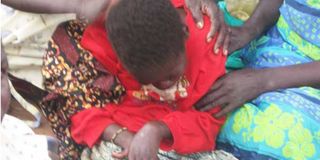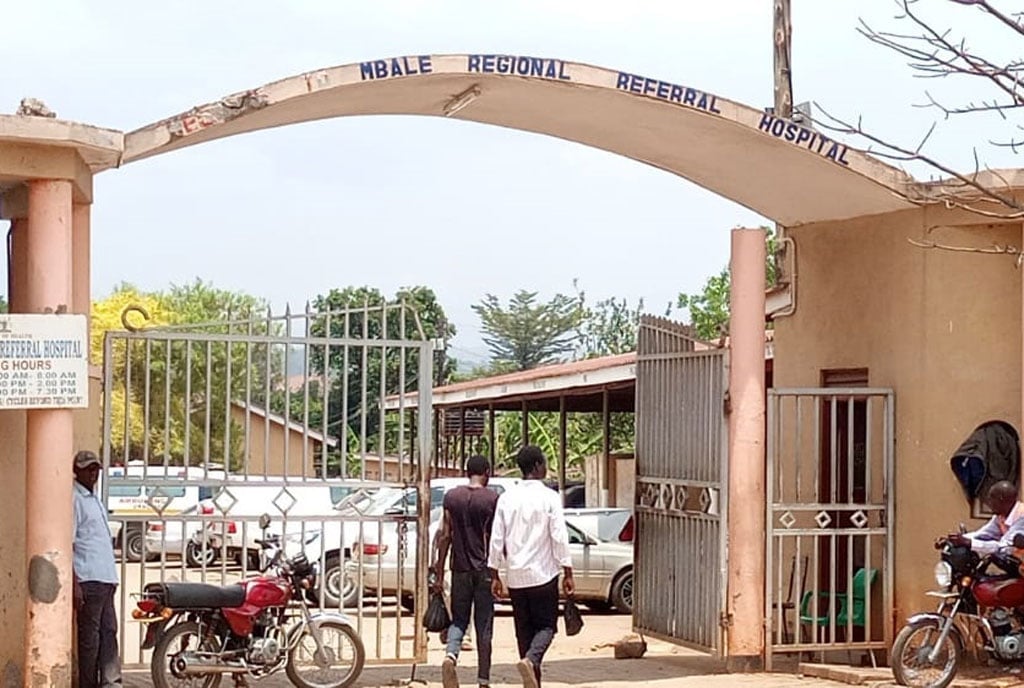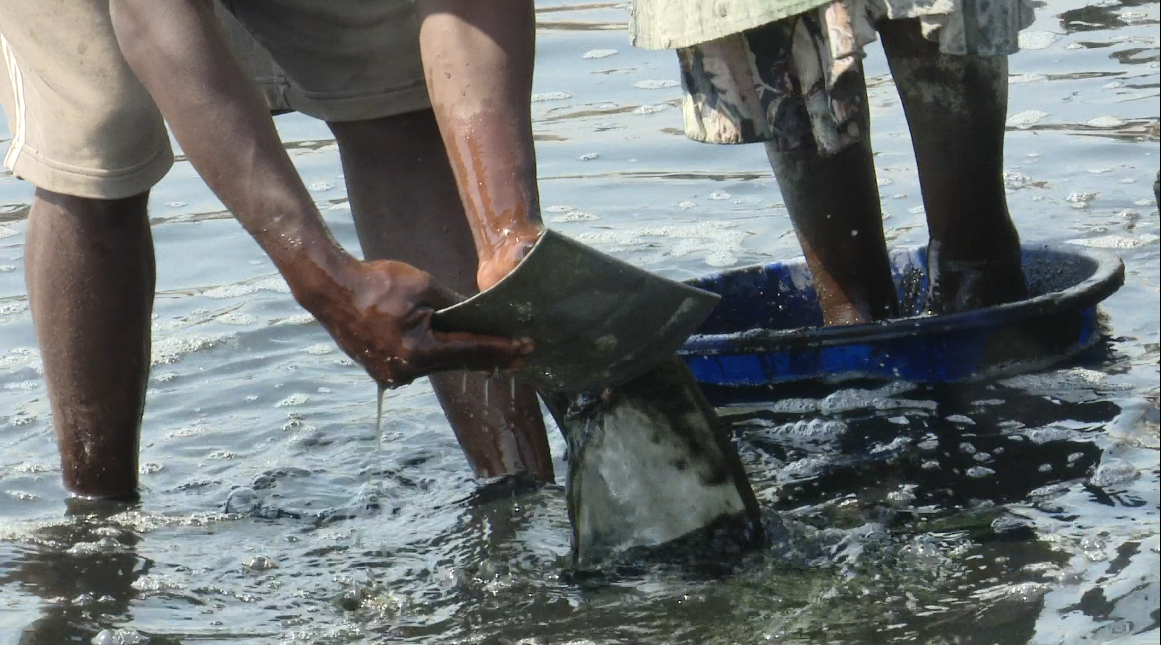Prime
Eight years of nodding: The mockery of govt response to the disease

A child suffering from the nodding disease syndrome in Kitgum District recently. Photo by Harriet Anena
What you need to know:
Thousands of children have fallen ill with the incurable ailment known as nodding disease.
Eight years ago, this month, three year old Sunday Apiyo started experiencing strange fits that her guardian suspected to be cerebral malaria for several days, sending her 70-year-old grandmother Rufia Lamaji into panic.
Ms Lamaji, of Lapul, Atanga Sub-county in Pader District, said she took her granddaughter to the hospital and also bought medicine from a drug shop for malaria but within weeks, her daughter’s condition had worsened.
“The fits continued and she started nodding her head whenever she was given food besides losing weight,” she said.
Apiyo, now 11, can pass for a three year-old-child.
In January 2010, we interacted with Ms Hellen Aol, who had that time had all three of her children malnourished and suffering from the unknown disease.
“There is a new disease that has started here making our children to be stunted in growth,” she said at Atanga Health Centre III where she and other parents had gone to collect fortified food that was being given by World Food Programme.
These were some of the first reported cases of the mysterious nodding disease syndrome that has ravaged the northern Uganda districts of Pader and Kitgum.
However, eight years down the road, the story has been one pitying tale of an ignorant population caught unaware, fighting a mysterious illness that has sent many of their children to an early grave and a government caught napping as the unknown disease consumes the young people.
Initially seen by parents as a disease akin to epilepsy, the disease has spread terror and mayhem across the region to a level commensurate to two-decade onslaught by the Lord’s Resistance Army rebels.
Eight years since the first cases were reported and three years since government’s first response, the government, however, continues gambling with anti-nodding and seizure medicines, without evidence on how the disease is spread, or if it mutates, or what causes it.
Government’s interventions, in form of material and medical support to nodding patients, have largely remained minimal and sluggish in coming.
Despite putting up treatment centres in the affected four districts of Kitgum, Pader, Lamwo and Gulu, majority of affected children are still in homes, most unable to trek to health centres to pick medications
Although the Ministry of Health puts the number of affected children at 3, 500, a new World Health Organisation report places the number at 7,000.
The argument about numbers aside, the government is yet to discover the actual cause of nodding disease.
The government’s first known response to the disease came in 2009 after numerous complaints from the local community.
Residents of Lapul recount how, that year, the government sent a team to Aruu Falls that surveyed the area before warning that they should keep away from the falls and promising to deliver drugs against black fly.
The drugs never came as much, and district leaders made several appeals to the government but nothing came forth.
However, the government will today, officially launch the mass taking of onchorcerciasis drugs that it promised in 2009 in Angagura Sub-county at a function that will be graced by President Museveni.
Slow response
Today’s function, coming almost four years since it was promised is used as an example by local leaders of government’s snail pace response to the mysterious disease.
To show their dissatisfaction, last December, a number of children from Lapul in Atanga Sub-county were taken to Mulago Hospital, in Kampala, for medical checkup to which some responded. But upon returning home, the parents Saturday Monitor talked to say the drugs got finished early in the year and the conditions of their children worsened.
“I cannot serve a sick population as if we are not part of this country. The children are no longer able to study and are destroyed,” said Pader LC5 chairman Alfred Akena in October last year amidst the sight of placard wielding residents condemning the government’s response to the disease.
Amidst collective cries for help, government in January launched a plan to manage the diseased.
It promised to set up treatment centres, build outreaches, supply drugs, provide food and take care of the welfare of patients at the nodding centres and home and carry out sensitisation.
The fulfillment of the promises is however coming at a snail pace and last week, Members of Parliament from the region described government’s response as “inadequate” and want the area declared a humanitarian disaster region.
This way, they hoped, it would attract the attention of the people responsible and other organisation that might come to their help.
The first figures presented about the disease, following a 2009 epidemiological investigation conducted by the government, put the figures at 170 deaths and 3,094 infections.
For three years, the government relied on this figure until towards the end of 2011, following reports of increasing deaths and infections, and did a similar survey early this year that put the number of infected children at 5,000 and deaths at about 205 according to the Ministry of Health. The World Health Organisation, however, says the figure stands at 7,000.
The world renowned Atlanta-based Centres for Disease Control (CDC) that released a report last year but gave no cause or say what the disease is, has promised more research and is expected to release their latest finding this month.
Dr Scott Dowell, from the CDC’s Division of Disease Detection & Emergency Response, early this year said: “It really is very tightly clustered between five and 15 years of age,” he says. “In the study we did in northern Uganda 93 per cent of kids were in that age window and I don’t know why that is.”
The World Health Organisation has also promised more research, as did Gulu and Makerere universities.
Asked if it is financial strain delaying the research, Prof. Emilio Ovuga, the dean faculty of medicine Gulu University, said: “Yes, that is actually what is delaying us. We don’t have funding.”
The community meanwhile says they are seeing many emerging cases including in adults like 40-year-old Licantorina Aryemo of Tumangu village in Akwang Sub-county, Kitgum District, who has been suffering from the disease since 2009.
The National Coordinator for Nodding Disease Response, Dr Bernard Opar, however, insists that no adult has yet contracted the disease, adding that the suspected patients could have contracted the disease years ago while still teenagers.
“To say new cases are cropping up in adults is wrong, that could be epilepsy,” he said, adding that some people are confusing nodding disease with epilepsy.
In a bid to give some relief to the children suffering from the disease, the government in February supplied antiepileptic drugs and opened treatment centres in the sub-region.
The first treatment centres were opened in Atanga Health Centre III, Palabek Kal Health Centre III and Kitgum hospital in March.
The centres are, however, sometimes over stretched by the high number of people turning up, at time running out of medicines.
“We feel that the government should speed up the process of getting the drugs because we are wasting a lot of valuable time in caring for these children without knowing their fate,” says Michael Odongkara of Lapul, whose 12-year-old daughter Nancy Lamwaka suffers from the disease.
The officer in-charge of Atanga Health Centre III, Mr David Nokrach, said the facility receives close to 100 fresh cases for diagnosis each day, adding that it stretches the few health workers in the health facility.
The health centre is sometimes faced with inadequate supply of anti-epileptic drugs Carbamazepine, Phenytoin and Sodium Valproate and relies on a vehicle from the district to get the supply from the National Drugs Store.
Early last month, some of the parents of the children admitted at the facility threatened to leave because they failed to get the drugs for one week after a vehicle bringing the supply from Kampala was involved in an accident in Kamdini on Kampala Road.
With the establishment of the facility, came the problem of transport since the children’s condition requires that they be transported to the health facilities in vehicles for fear that they could get fits when on a bicycle or a motorcycle.
The government promised four 14-seater vans and eight motorcycles to the three affected districts but this has not materialised due to procurement bureaucracies.
As such, the health facilities are constrained to carrying out outreaches in the community and the sick children with need for urgent medical attention are left stranded at home.
Mr Odongkara said his daughter Nancy Lamwaka 12, nearly died last month after her condition deteriorated from their home in Lapul, about seven kilometres from Atanga Health Centre III.
It took him three weeks to get a vehicle to transport her to the health centre.
The officer in-charge, Mr Nokrach estimates the number of cases in the community that are yet to be screened at over 900.
Meanwhile, in Kitgum hospital, nodding disease focal point person Joseph Oweka, identified the challenge of getting parents to take their children for screening as one of the main problems they are facing in combatting the disease.
“We are aware of that (transport challenge) and that is why we are providing the vans to start the outreach in the communities” says Ms Nakamatte.
Besides lack of drugs, one of the biggest challenges is now lack of food. Last month, caretakers of children threatened to abandon Atanga Health Centre III over lack of food. The four kilogrammes of posho and beans, supplied by the Prime Minister’s office, had run out and food has been in short supply.
“The provision of food to the children is the biggest problem we face since they need to be fed well,” says 80-year-old Terina Aryemo from Lamola in Amida Sub-county, Kitgum District.
To fill the gap, World Vision Uganda last week supplied an assortment of items including 2,000kgs of beans, 1000kgs of maize flour, 200 litres of cooking oil, 8 boxes of washing soap, 200 blankets and 400 sweaters and blankets.
As part of their response, the government had promised outreach programmes, this is also yet to be delivered.
The Ministry of Health says it is yet to get the initial budget of Shs7 billion it requested for while the Information Minister, Ms Mary Karoro Okurut told journalist last month that additional money is required to effectively fight the disease.




